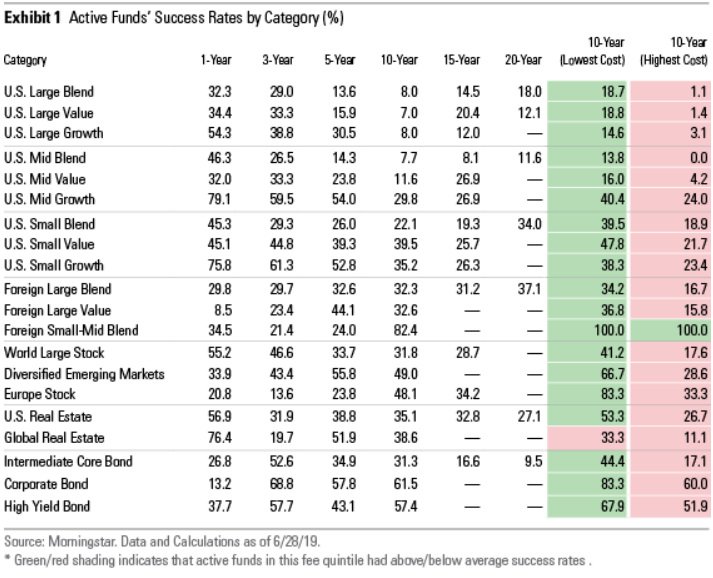What Is Passive Investing?
We break down what it is and how it works.
The end of August marked a historic investing moment. Money invested in passive U.S. equity funds surpassed 946,059 active funds. This is a major milestone that reflects a shift in investor preferences toward lower-cost investing.
If you’re just starting to invest, you may have heard about passive investing but you might not know exactly what it means or how it works. Let’s break it down.
What is passive investing? The goal of passive investing is to replicate the return earned by a part of the market. You can do this by buying a fund that mimics the return of a certain benchmark index. Because an index represents a slice of the market, mimicking it lets investors earn what that segment does.
By contrast, active management’s goal is to beat the market segment by trying to select the investments that will perform best.
How can I buy a passive investment? There are two types of passive investments.
The first is through an index mutual fund. Investors pool their money together, and a manager invests it on the group’s behalf. With index funds, the manager chooses investments to mimic the benchmark. (Some index funds buy all the stocks in their benchmark index, while others use optimized sampling to closely match the index’s return without owning every security.)
Exchange-traded funds track an index in a similar manner, too, but the structure is a little different; you’re not pooling your money with others. Investors buy and sell exchange-traded fund shares on exchanges, similar to stocks.
Exchange-traded funds and mutual funds are similar, but they have subtle differences worth considering.
Why would I want a passive investment if I could beat the market with an active investment? Active investing doesn't often work.
It's difficult to beat the market. You're competing against many other investors, so it's hard to have an analytical edge. Active funds also need to hire managers and analysts to research securities. These costs add an additional fee hurdle, so even if a team running an active mutual fund has investing merit, they must outperform the market and their costs. These issues result in most active funds underperforming their benchmark.
Compare this with passive funds. You’ll earn what the benchmark does (or close to it). Plus, there’s no team needed to research securities, which means passive funds are often meaningfully cheaper than their active counterparts.
Does this mean I should only use passive? Not necessarily, because some active funds beat the market. It depends on your goals. You can have incredible success earning just the market's return, so an entirely passive portfolio is a solid choice. But if you enjoy the thrill of beating the market, consider these two factors when picking active funds.
First, low-cost active funds hold up better in some market segments. For instance, small-cap active funds have better success than large-cap ones. Tinier businesses have fewer researchers analyzing them, so it's likelier small-cap analysts have a differentiated view on a stock they believe is inefficiently priced. My colleague Ben Johnson publishes a biannual report supporting this.

The image shows low-cost active small-cap and mid-cap funds have more success beating their benchmarks than large-cap funds over longer time horizons. It also highlights other fruitful spaces, such as active bond funds.
Second, our analysts diligently research active funds and determine the best ones. Our Morningstar Analyst Rating assigns promising funds a Bronze, Silver, or Gold rating depending on our conviction, with Gold being the best. This list includes our favorite small-cap picks, both passive and active.
Selecting a Gold-rated fund in a fruitful category maximizes your chance of finding a successful active fund.
Do tax costs affect a passive investment's attractiveness? Yes. In a taxable account, you'd almost always want passive funds (especially ETFs). They're more tax-efficient for two reasons.
First, both ETFs and index funds trade securities infrequently. Active managers buy and sell securities based on their changing merit, incurring capital gains taxes when a security is sold for a gain.
Second, the ETF structure curbs capital-gain distributions, a pesky tax burden that can cost index-fund and active-fund investors at tax time.
Are there any risks with passive? You might assume passive equals safe, but the investment will fare poorly if its market segment does. Further, some benchmarks are heavily concentrated in a few holdings, introducing stock-specific risk. For instance, the S&P 500 contains the 500 largest U.S. companies, so you might think you're owning minuscule fractions of these businesses. But at month-end August 2019, for every $100 you invested, more than $20 would go into the 10 largest companies.
This isn’t to say passive funds aren’t a good option, but you’ll want to consider your risk tolerance when buying them, as well as how they fit within the context of your portfolio.

/s3.amazonaws.com/arc-authors/morningstar/b70d0063-c0bd-47f4-a1f5-74ff9b0435b1.jpg)
/cloudfront-us-east-1.images.arcpublishing.com/morningstar/EC7LK4HAG4BRKAYRRDWZ2NF3TY.jpg)
/cloudfront-us-east-1.images.arcpublishing.com/morningstar/JNGGL2QVKFA43PRVR44O6RYGEM.png)
/cloudfront-us-east-1.images.arcpublishing.com/morningstar/BC7NL2STP5HBHOC7VRD3P64GTU.png)
:quality(80)/s3.amazonaws.com/arc-authors/morningstar/b70d0063-c0bd-47f4-a1f5-74ff9b0435b1.jpg)